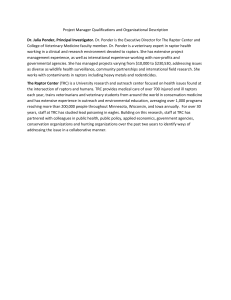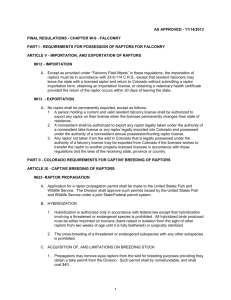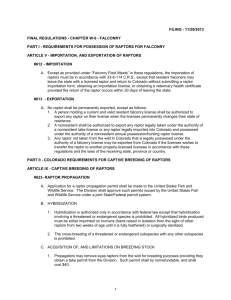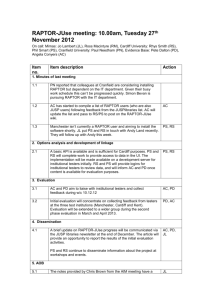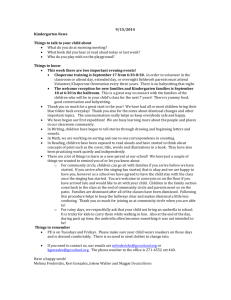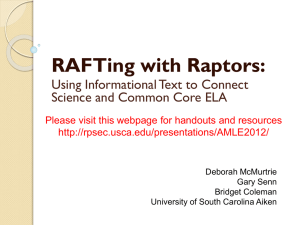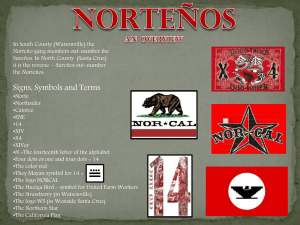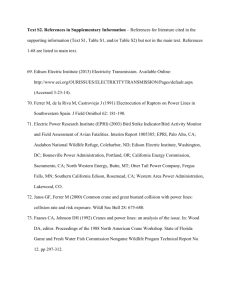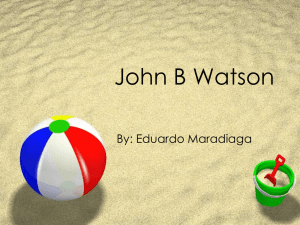here! - Watson Birds
advertisement
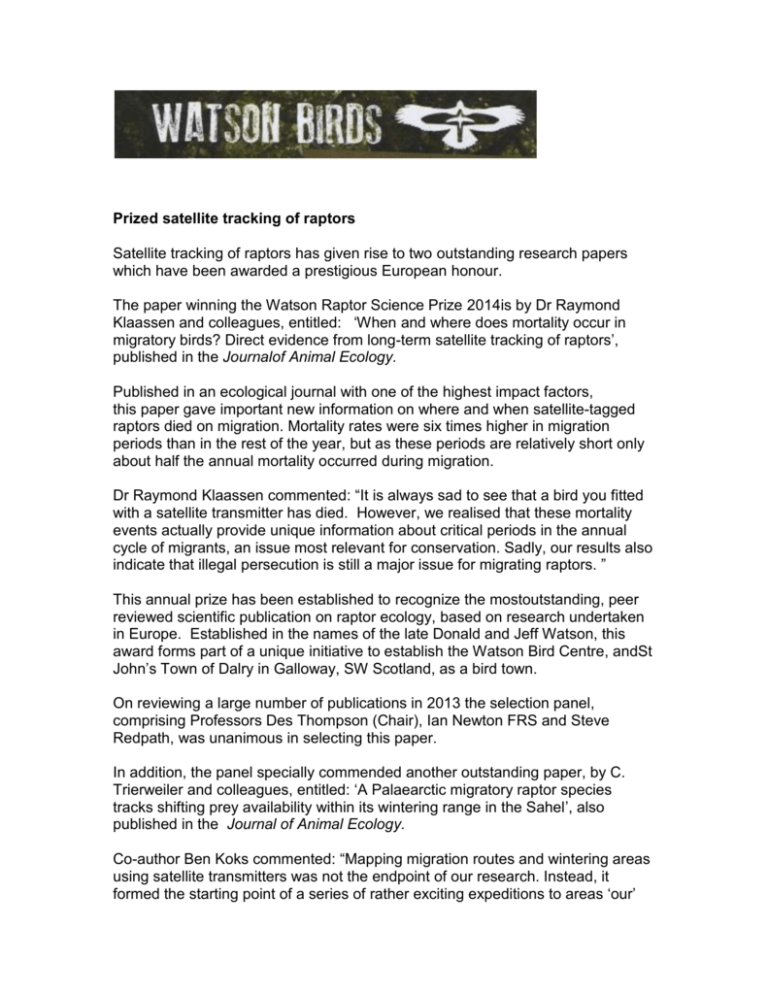
Prized satellite tracking of raptors Satellite tracking of raptors has given rise to two outstanding research papers which have been awarded a prestigious European honour. The paper winning the Watson Raptor Science Prize 2014is by Dr Raymond Klaassen and colleagues, entitled: ‘When and where does mortality occur in migratory birds? Direct evidence from long-term satellite tracking of raptors’, published in the Journalof Animal Ecology. Published in an ecological journal with one of the highest impact factors, this paper gave important new information on where and when satellite-tagged raptors died on migration. Mortality rates were six times higher in migration periods than in the rest of the year, but as these periods are relatively short only about half the annual mortality occurred during migration. Dr Raymond Klaassen commented: “It is always sad to see that a bird you fitted with a satellite transmitter has died. However, we realised that these mortality events actually provide unique information about critical periods in the annual cycle of migrants, an issue most relevant for conservation. Sadly, our results also indicate that illegal persecution is still a major issue for migrating raptors. ” This annual prize has been established to recognize the mostoutstanding, peer reviewed scientific publication on raptor ecology, based on research undertaken in Europe. Established in the names of the late Donald and Jeff Watson, this award forms part of a unique initiative to establish the Watson Bird Centre, andSt John’s Town of Dalry in Galloway, SW Scotland, as a bird town. On reviewing a large number of publications in 2013 the selection panel, comprising Professors Des Thompson (Chair), Ian Newton FRS and Steve Redpath, was unanimous in selecting this paper. In addition, the panel specially commended another outstanding paper, by C. Trierweiler and colleagues, entitled: ‘A Palaearctic migratory raptor species tracks shifting prey availability within its wintering range in the Sahel’, also published in the Journal of Animal Ecology. Co-author Ben Koks commented: “Mapping migration routes and wintering areas using satellite transmitters was not the endpoint of our research. Instead, it formed the starting point of a series of rather exciting expeditions to areas ‘our’ Montagu’s Harriers used during migration and in winter. On the tail of our transmitter birds we observed harriers struggling in depleted landscapes in Europe and Africa. “ Commenting on the selection, Professor Des Thompson stated: “Excellent research on raptors is being carried out in Europe, and we were struck this year by the superb findings emerging from satellite tracking of raptors. Raymond Klaassen, Ben Koks and colleagues have shown just how hazardous migration is for raptors. They provide an impressive quantification of fitness costs of migration. Our Prize Panel was spoilt for choice given the range of high quality science being published on raptors. ” Director of the Watson Bird Festival, Roger Crofts, commented: “Watson Birds is all about celebrating excellence, and the Watson Raptor Science Prize is a unique contribution. I thank the panel for their meticulous work. And I join the Panel members to warmly congratulate the authors of both papers. All that remains is for as many people as possible to join us on Saturday 20th September in Dalry to hear the talks by the authors and join in what is bound to be a stimulating debate on these wider implications of the research. I’m especially pleased that we will have Roy Dennis join us to talk about his work on raptors.” Notes 1. Meet the winners: Raymond Klaassen and Ben Koks will give public lectures on the two papers at St John’s Town of Dalry on Saturday 20 September from 2.00pm. Roy Dennis shall also be speaking. Details of the Watson Bird Centre and how to get to Dalry are found here:file:///C:/Users/apdt/Downloads/Watson_Birds_2014_Festival_progra mme.pdf 2. The full details of the winning paper are: Klaassen, R. H. G., Hake, M., Strandberg, R., Koks, B. J., Trierweiler, C., Exo, K.-M., Bairlein, F., Alerstam, T. (2014). When and where does mortality occur in migratory birds? Direct evidence from long-term satellite tracking of raptors. Journal of Animal Ecology, 83: 176–184. doi: 10.1111/1365-2656.12135. http://onlinelibrary.wiley.com/doi/10.1111/1365-2656.12135/abstract 3. The full details of the specially commended paper are: Trierweiler, C., Mullié, W. C., Drent, R. H., Exo, K.-M., Komdeur, J., Bairlein, F., Harouna, A., de Bakker, M., Koks, B. J. (2013). A Palaearctic migratory raptor species tracks shifting prey availability within its wintering range in the Sahel. Journal of Animal Ecology, 82: 107–120. doi: 10.1111/j.1365-2656.2012.02036.x. http://onlinelibrary.wiley.com/doi/10.1111/j.13652656.2012.02036.x/abstract 4. The Watson Raptor Science Prize is in its fourth year. This annual prize, established in the name of the late Donald and Jeff Watson, was set up to recognise the most outstanding, peer-reviewed scientific publication on raptor ecology, based on research undertaken in Europe. The 2013 Prizewas awarded to Professor Miguel Ferrer and colleagues for a study of risks of raptor mortality from wind farms: http://onlinelibrary.wiley.com/doi/10.1111/j.13652664.2011.02054.x/abstract. The runner-up was a study of the former distribution of golden eagles and sea eagles determined by place names in Britain and Ireland, awarded to Richard Evans and colleagues: http://www.tandfonline.com/doi/abs/10.1080/00063657.2012.683388#previ ew. The 2012 Prize was awarded to Dr FabrizioSergio for his paper: ‘Raptor nest decorations are a reliable threat against conspecifics’. Science (2011), 331: 327-330. A paper by Dr Arjun Amar and colleagues at the RSPB on Orkney’s hen harriers was specially commended: http://onlinelibrary.wiley.com/doi/10.1111/j.13652664.2010.01896.x/abstract. The 2011 Prize was awarded to Dr Jen Smart and colleagues at the RSPB for their research paper on persecution of red kites in the Scottish Highlands: http://www.rspb.org.uk/Images/smart_amar_sim_et_al_2010_tcm9248263.pdf Ends.
